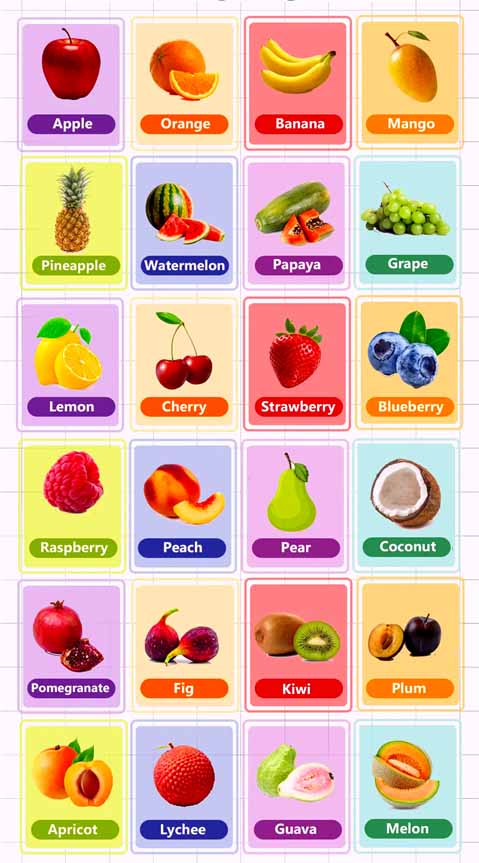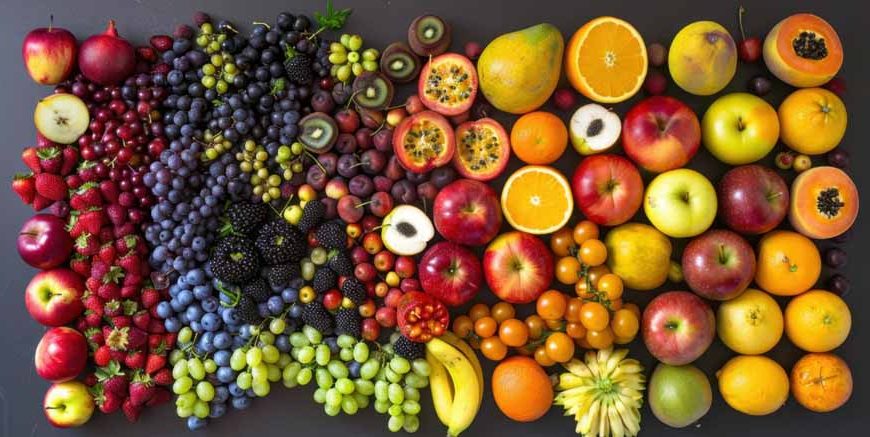“Apple” or “Safarchand,” no matter what you call it, the taste of an apple remains the same! Just like fruits come in many varieties, their names also change across languages. For example, the humble Banana is called Kela in Hindi and Vazhaipazham in Tamil.
Most of us know different fruit names in English and maybe Hindi, but have you stopped to think what a pineapple or a pear is called in Tamil or Marathi? In this article, we have compiled a list of fruit names in English and Hindi, as well as Marathi and Tamil, helping you and your little one explore the world of fruits and their names.
50 Fruits’ Names in English, Hindi, Marathi, and Tamil
We have all grown up eating fruits like apples, pears, pomegranates, watermelons, oranges, etc. However, we don’t call these fruits with the same names, do we? Here, we have listed all fruit names in English, Hindi, Marathi, and Tamil.

A to Z Fruits’ Names in English and Hindi, as well as Marathi and Tamil
|
Sr. No |
Fruits’ Names in English |
Fruits’ Names in Hindi |
Fruits’ Names in Tamil |
Fruits’ Names in Marathi |
|
1 |
Apple |
Seb |
Applepazham |
Safarchand |
|
2 |
Apricot |
Khubani |
Sarkkarai Badami |
Jardalu |
|
3 |
Avocado |
Makhanphal |
Vennai Pazham |
Avocado |
|
4 |
Banana |
Kela |
Vazhaipazham |
Kela |
|
5 |
Black Plum (Java Plum) |
Jamun |
Naval Pazham |
Jambhul |
|
6 |
Blueberry |
Neelbadri |
Neelam Pazham |
Blueberry |
|
7 |
Cantaloupe |
Kharbooja |
Mushmelon |
Kharbuj |
|
8 |
Cherry |
Cherry |
Cherry |
Cherry |
|
9 |
Coconut |
Nariyal |
Thengai |
Naral |
|
10 |
Cranberry |
Karaunda |
Kurunji Pazham |
Karvand |
|
11 |
Custard Apple |
Sitaphal |
Seetha Pazham |
Sitaphal |
|
12 |
Dates |
Khajoor |
Pericham Pazham |
Kharik |
|
13 |
Dragon Fruit |
Pitaya |
Pithaya Pazham |
Dragon Phal |
|
14 |
Fig |
Anjeer |
Athipazham |
Anjir |
|
15 |
Gooseberry (Indian) |
Amla |
Nellikai |
Awla |
|
16 |
Grapefruit |
Chakotara |
Tiratchai Pazham |
Drakshaphal |
|
17 |
Grapes |
Angoor |
Draksha |
Draksha |
|
18 |
Guava |
Amrud |
Koyyapazham |
Peru |
|
19 |
Jackfruit |
Kathal |
Palapazham |
Phanas |
|
20 |
Jujube (Indian Plum) |
Ber |
Elantha Pazham |
Bor |
|
21 |
Kiwi |
Kiwi Phal |
Kiwi Pazham |
Kiwi Phal |
|
22 |
Lemon |
Nimbu |
Elumichai |
Limbu |
|
23 |
Lychee |
Litchi |
Litchi Pazham |
Lichi |
|
24 |
Mango |
Aam |
Mambazham |
Amba |
|
25 |
Mulberry |
Shehtoot |
Muththandipazham |
Tuti |
|
26 |
Musk Melon |
Kharbooja |
Kirnipazham |
Kharbuj |
|
27 |
Olive |
Jaitun |
Kath Olai |
Jaitun |
|
28 |
Orange |
Santra |
Kichilipazham |
Santra |
|
29 |
Papaya |
Papita |
Pappali |
Papai |
|
30 |
Passion Fruit |
Krishna Phal |
Passi Pazham |
Passion Phal |
|
31 |
Peach |
Aadoo |
Peetch Pazham |
Peach |
|
32 |
Pear |
Nashpati |
Berikkai |
Nashpati |
|
33 |
Pineapple |
Ananas |
Annachi Pazham |
Ananas |
|
34 |
Plum |
Alu Bukhara |
Alpakoda Pazham |
Alpakoda |
|
35 |
Pomegranate |
Anar |
Madhulai |
Dalimb |
|
36 |
Raspberry |
Rasbhari |
Iruppacch Pazham |
Raspberry |
|
37 |
Rose Apple |
Gulab Jamun |
Paneer Pazham |
Jambhul |
|
38 |
Sapota |
Chikoo |
Sapota |
Chiku |
|
39 |
Starfruit (Carambola) |
Kamrakh |
Thambaratham |
Karambola |
|
40 |
Strawberry |
Strawberry |
Strawberry |
Strawberry |
|
41 |
Sugar Apple |
Sharifa |
Sitapazham |
Sitaphal |
|
42 |
Sweet Lime |
Mosambi |
Sathukudi |
Mosambi |
|
43 |
Tamarind |
Imli |
Puli |
Chinch |
|
44 |
Water Chestnut |
Singhada |
Nirppuli |
Shingada |
|
45 |
Watermelon |
Tarbooj |
Tharpoosani |
Kalingad |
|
46 |
White Sapote |
Vilayati Chikoo |
Vellai Sapota |
Safed Chikoo |
|
47 |
Wood Apple |
Bael |
Vilam Pazham |
Kavath |
|
48 |
Ziziphus (Jujube) |
Ber |
Elantha Pazham |
Bor |
|
49 |
Blackberry |
Jamun |
Karuppu Naval |
Jambhul |
|
50 |
Custard Apple (Wild) |
Jungle Sitaphal |
Mullu Sitapazham |
Jungli Sitaphal |
Also Read: Best Summer Season Fruits for Children
A Little About Different Types of Fruits
There are various types of fruits, divided based on their colour, origin, and the climate in which they grow. Here are four types of fruits:
- Citrus fruits
- Tropical fruits
- Yellow fruits
- Green fruits
Let’s examine these types of fruits with examples.
- Citrus Fruits: These fruits grow in subtropical climates and are packed with Vitamin C and other nutrients. Here are some examples of citrus fruits:
- Orange
- Lemon
- Grapefruit
- Tangerine
- Tropical Fruits: These fruits thrive in hot and humid climates near the equator. Here are some examples of tropical fruits:
- Mango
- Papaya
- Banana
- Pineapple
- Lychee
- Yellow Fruits: Fruits that are yellow outside or inside are called yellow fruits. Here are some examples of yellow fruits:
- Yellow pear
- Golden kiwi
- Yellow watermelon
- Cantaloupe or Sweet melon
- Green Fruits: These fruits have a green peel or pulp and are rich in nutrients. Here are some examples of green fruits:
- Green apple
- Guava
- Kiwi
- Custard apple
Also Read: Unveiling the Citrus Wonderland: Names, Types, and Playful Adventures for Kids
Also Read: A Comprehensive Guide on Green Fruits: A Parent’s Guide
How to Eat Fruits? Fun Facts and Tips
Fruits are packed with vitamins, minerals, and fibre, making them essential for a healthy body and glowing skin. To get the most nutrients from them, follow these simple tips on choosing, storing, and eating fruits wisely.
Fruits are packed with vitamins, minerals, and fibre, making them essential for a healthy body and glowing skin. To get the most nutrients from them, follow these simple tips on choosing, storing, and eating fruits wisely.
- How to Choose and Store Fruits
- Pick fruits that have bright colours and a fresh, pleasant smell. For soft fruits like mangoes, avocados, and sapota, gently press the skin—it should give slightly if the fruit is ripe.
- Always rinse fruits well before eating. To remove pesticides, soak them in water with a little vinegar, baking soda, or salt for about 5 minutes.
- When storing fruits, avoid cutting them too soon. Once chopped, they start losing nutrients, so eat them right away. Keeping cut fruits in the fridge for too long can also reduce their benefits.
- Best Way to Eat Fruits
- The healthiest way to eat fruits is in their natural form—whole and fresh. Peeling is only needed if the skin is tough or inedible. Remove any hard seeds or stones before eating.
- Try not to drink water immediately after eating fruits. It can dilute their nutrients, so wait at least 30 minutes before drinking.
- Avoid consuming fruits right after meals. Instead, eat them at least 2 hours before or 2-3 hours after a meal for better digestion.
- Pairing Fruits the Right Way
- Be mindful when mixing fruits. Avoid combining acidic fruits like oranges and lemons with sweet fruits in smoothies, juices, or desserts.
- Never mix melons with other fruits, as they digest differently and may cause bloating or discomfort.
Why Eating Whole Fruits is Better
- Whole fruits contain fibre, vitamins, minerals, and antioxidants that help the body stay strong and fight diseases.
- Processing fruits—like juicing, pureeing, or dehydrating—remove fibre and reduces their natural benefits. Juices lose fibre, purees lose water content, and dried fruits become high in sugar, harming teeth.
By following these simple tips, parents can ensure their children eat fruits the right way, getting all the essential nutrients for growth and good health.
Frequently Asked Questions (FAQs) on Fruits and Their Names
Why is it important to know the fruits’ names in English and other languages?
Learning about fruits and their names in different languages improves your little one’s vocabulary. Therefore, as soon as you enrol your child into a kindergarten, start teaching them all the names of fruits in English, Hindi, and other languages.
What are 20 juicy fruits in English?
Here are 20 juicy fruits and their names:
- Mango
- Banana
- Papaya
- Pineapple
- Guava
- Passion fruit
- Avocado
- Orange
- Watermelon
- Lychee
- Grapes
- Strawberry
- Apple
- Kiwi
- Peach
- Plum
- Pomegranate
- Blueberry
- Cherry
- Muskmelon
These fruits are sweet, juicy, and perfect for fresh snacks, juices, and smoothies.
How many types of fruits are there in the world?
There are over 2,000 types of fruits in the world. The fruits we eat every day are just a small part of the global variety.
Summing Up
In this article, we have listed different fruits and their names in English and other languages. We at EuroKids strongly encourage parents to inculcate healthy eating habits by including more fruits and vegetables in their diet. Check out our blog, Healthy Habits For Little Ones: Celebrating World Health Day In Preschool , for tips. You can also visit EuroKids Blogs for more insights on your little one’s development, health, and learning. Don’t forget to visit EuroKids Preschools for the perfect first step in your child’s learning journey.
Related Blogs:
- Infant Fruit Guide: Introducing fruits to infants helps build healthy eating habits early. This guide provides feeding tips and explains how to safely incorporate them into your baby’s diet.
- Papaya for Kids: Papaya is a nutrient-rich fruit that supports digestion and boosts immunity in children. Learn how to serve it safely and creatively to make it more appealing for young eaters.
- Teaching Fruits and Vegetables Names to Preschoolers: Teaching fruit and vegetable names through songs, stories, and games makes learning fun for preschoolers. This article shares playful methods to build vocabulary and encourage healthy food choices.
- Exploring Dry Fruits: Dry fruits are packed with nutrients and make excellent snacks for growing kids. Discover the benefits of almonds, raisins, cashews, and more, along with fun ways to include them in meals.















